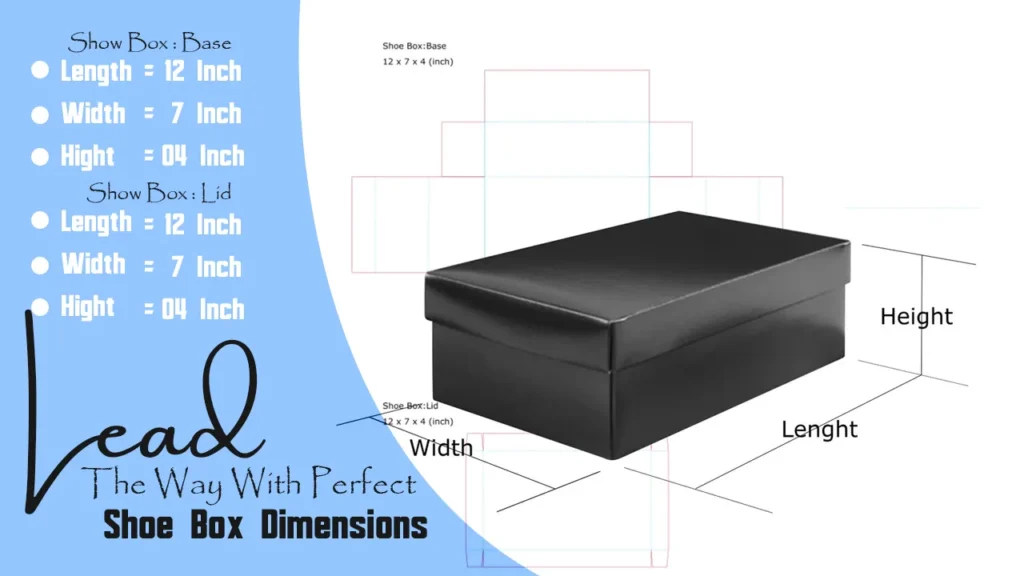Are you tired of seeing shoe boxes that don’t fit your favorite sneakers? Or if you’re the one who’s going to start a shoebox brand. Good news! your problem ends here. Once you understand shoe box dimensions, you’ll never struggle again with mismatched sizes. Shoe boxes differ in size, ranging from exquisite to functional.
Shoe box dimensions can be a difficult problem because shoe box sizes vary for men, women, and kids. Due to conflicts, adult shoes can’t be kept in a kid-sized shoe box. The right sizes of shoe boxes make a difference in the market and keep the shoes protected. In this blog post, BizzCrave will explore in-depth information about different sizes and styles of shoe boxes.
Dimensions That Perform: Significance of Measuring Shoe Box Dimensions
With high-quality shoes inside, perfectly shaped shoe boxes coincide with numerous benefits. Starting protection from shelf to shipping, the perfect shoe box dimensions proved fruitful for many shoe brands. The following are some of the main benefits of precise shoe box sizes.
Perfectly sized shoe boxes:
- Protecting from dirt and dust ensures the integrity of the valuable shoes inside.
- Avoid misplacement of shoes during the harsh shipping process.
- Perfect presentation of shoe boxes arranged on the shelf of the store.
- Increase visual appeals and increase customers.
- Improve company standards by using a distinctive logo and branding elements.
- Extend the shoe’s lifespan by preserving them from the harsh environment outside.
- Make it simple for shoe boxes to be stacked over racks in the retail establishment.
- Reduce material waste and shipping costs.
- Improve the unboxing experience of the customers.
- Stand out in competition with its unique customizations.
What Are Average Shoe Box Dimensions? Panel Measurements
Shoe box dimensions vary greatly depending on the category of shoes (men’s, women’s, kids). But there could be a standard measurement. We briefly explain standard shoe box sizes by panel measurements.
Front and Back panel (Length X Height)
The front and back panels of the shoe box present your brand on the shelf. Brands use these panels for printing logos to enhance their visual appeal. The front and back panels of the men’s shoe box have dimensions of 13 X 4 inches. Whereas, women’s shoe boxes occupy front and back panels of 12 X 4 inches. The size of a shoe box’s front and rear panels is determined by the kind of shoe it is intended to hold.
Top and Bottom Panel (Length X Width)
The top and bottom panels of the shoe boxes help to maintain box integrity. The top panel ensures easy opening while the bottom panel keeps the base solid. The men’s shoe box’s front and back panels measure 13 by 4 inches. On the other hand, women’s shoe boxes come with 12 X 7 inches as they are sleeker and stylish.
Side Panels (Width X Height)
Side panels of shoe boxes often provide the size and color information of the shoe pair inside. In men’s side panels are 7 X 4 inches, while in women’s shoe boxes, these measurements remain the same.
Keep in mind that different shoe types require different dimensions to perfectly fit in them.
Standard Shoe Box Dimensions Beyond Panel Measurements
| Box Type | Length | Width | Height |
| Men’s shoe box | 13 to 14 inches(33.02 to 35.56 cm) | 7 to 8 inches (17.78 to 20.32 cm) | 4 to 5 inches (10.16 to 12.7 cm) |
| Women’s shoe box | 12 to 13 (30.48 to 33.02 cm) | 7 to 8(17.78 to 20.32 cm) | 4 to 5 inches (10.16 to 12.7 cm) |
| Children shoe box | 7 to 10(17.78 to 25.4 cm) | 5 to 6(12.7 to 15.24 cm) | 2 to 3 inches(5.08 to 7.62 cm) |
How Thick Should Shoe Box Walls Be?
The shoe box walls’ thickness determines whether the box is local or premium and affects shoe quality. In general, shoe brands adhere to their cardboard to have a thickness of 1.5 to 2 mm. Because of their perfect thickness, shoe boxes are both affordable and portable.
What Should Be the Ideal Weight of the Shoe Box?
Shoe size (small, medium, and large) and material thickness are two of the many variables that affect shoe box weight. On the other hand, a shoe box made of cardboard or paperboard weighs 1.5 to 10 pounds. The thickness of shoe boxes determines their weight. Therefore, a suitable thick shoe box is more substantial and contributes to better shoe protection during shipping.
What Should Be The Volume of a Standard Shoe Box?
The formula length x width x height can be used to determine the shoe box’s volume. By stepping into the mean dimension into the given formula, we can calculate the typical shoe box volume, or 385 cubic inches.
Fit For Every Footwear: Explore Different Shoe Box Dimensions By Type
Your favorite sneakers may not fit in a shoe box that is either too big or too small. Shoe box size and quality are closely related for a shoe brand to be successful in the market. BizzCrave mentions about the various kinds of shoe boxes and their measurements below.
Men’s Shoe Box
Because each shoe type and style is different, men’s shoe box dimensions are divided into a number of categories based on the type of shoe.
| Shoe Type | Length | Width | Height |
| Dress Shoes | 13 inches (33.02cm) | 7 inches (17.78cm) | 5 inches (12.7cm) |
| Boots | 14 inches (35.46cm) | 8 inches (20.32cm) | 6 inches (15.24cm) |
| Loafer | 12 inches (30.48cm) | 7 inches (17.78 cm) | 4 inches (10.16cm) |
| Athletic shoes | 13 inches (33.02cm) | 7 inches (17.78 cm) | 5 inches (12.7 cm) |
Women’s Shoe Box
Ladies shoe boxes are available in a range of sizes due to their fashionable and cutting-edge design. Their flat footwear require a smaller box than their sandals with high heels. Women’s shoe boxes come in a wide range of dimensions and designs.
| Shoe Type | Length | Width | Height |
| High Heels | 12 inches (30.48cm) | 7 inches (17.78cm) | 5 inches (12.7cm) |
| Flat | 11 inches (27.94cm) | 6 inches (15.24cm) | 4 inches (10.16cm) |
| Sandals | 12 inches (30.48cm) | 7 inches (17.78cm) | 4 inches (10.16cm) |
| Flip Flop | 10 inches (25.4cm) | 6 inches (15.24cm) | 3 inches (7.62cm) |
Children Shoe Box
There are also numerous types of shoe boxes for kids. From infants to teenagers, each shoe box has a unique size.
| Age Group | Length | Width | Height |
| Infants (0-2 years) | 7 inches (17.78cm) | 4 inches (10.16cm) | 3 inches (7.62cm) |
| Toddlers (2-4 years) | 9 inches (22.86cm) | 5 inches (12.7cm) | 4 inches (10.16cm) |
| Preschoolers (4-6 years) | 9 inches (22.86cm) | 6 inches (15.24cm) | 4 inches (10.16cm) |
| School-Age (6-12 years) | 11 inches (27.94cm) | 7 inches (17.78cm) | 5 inches (12.7cm) |
Shoe Box Dimensions of International Shoe Brands
The shoe packaging designs of many popular shoe brands, including Gucci and Nike, are recognized. They have gained popularity worldwide for the unique design and caliber of their apparel. Their personalized shoes attract customers. Such strategies make their presence valuable at a global level. Learn about their average shoe box dimensions in tabular form.
| Brand Name | Shoe Type | Average Dimensions | Box Material |
| Puma | Women’s shoes | 13” X 7.4” X 5.4” | Recycled Cardboard |
| Gucci | Tennis shoes | 13.5” X 7.5” X 5” | Cardboard |
| Fila | Men’s shoes | 13.25” X 10” X 5” | Recycled Paper and Cardboard |
| Jordan | Casual shoes | 13” X 10.5” X 5.5” | Corrugated Cardboard |
| Nike | Men’s sneakers | 13.4” X 9.4” X 4.7” | Recycled Cardboard |
| Adidas | Women’s sneakers | 12.6” X 7.9” X 4” | Paper Cardboard |
| Reebok | Athlete shoes | 13” X 8.7” x 4.3” | Cardboard |
| Skechers | Casual sneakers | 12.2” X 7.5” X 4” | Recycled Board |
International Shipping Standards For Shoe Box Sizes?
Searching for international norms? Making a shoe box requires careful consideration of international shipping regulations. These might differ from one nation to another, but they are crucial. Take a look at:
- Dimensional Weight: In certain nations, shipping charges are set by the size of the package rather than its weight. Choose lightweight, room-saving boxes to prevent dimensional weight penalties.
- Custom regulations: Shipping permits are required for materials like wood. For easy customs clearance, use environmentally friendly substitutes like cardboard.
- Maximum Dimensions: Many nations have shoe box size restrictions; adhere to them to prevent repackaging.
Researching regulatory compliance should always be a priority. This will guarantee the safe delivery of your shoes and spare you from hassles.
Why Shoe Box Dimensions Matter for E-commerce Brands
Shoe box dimensions optimize the shipping cost by using the dimensional weight pricing method. If they are accurately sized, then they protect the shoes and prevent them from returning. However, they help to establish the brand’s loyalty and customer satisfaction. Proper sizing improves warehouse space utilization and contributes to a clean and creative unboxing experience. They give e-commerce brands, a competitive edge across the environmental effect.
How To Measure The Perfect Shoe Box Dimensions? Step By Step
Use these easy steps to find the shoe box’s dimensions.
Step 01: Choosing an Instrument
Take a measuring tape, ruler, or calliper.
Step 02: Measure the Length
For length measurement, place the box on a table and start measuring from left to right. For the shoe box’s air circulation, an additional 0.079 inches of space must be added.
Step 03: Measure the Height
Now measure the height of the box. For this measure, the box is from top to bottom, and again, add some extra space of about 0.079 inches.
Step 04: Measure the Width
Lastly, measure the width of the shoe box from left to right across the shorter side and add additional space to its measurement, too.
Note down all the measurements in centimeters or inches.
Unique Customization options for Shoe Boxes
Customization techniques can further improve shoe boxes with images of the ideal size. The shoe boxes’ attractiveness is enhanced by the choices of materials, prints, and finishes.
| Material Options | Corrugated CardboardRigid Box BoardKraft PaperPaper Board Recycled Material |
| Printing Techniques | Screen PrintingDigital PrintingFull Color Printing (CMYK)Flexography |
| Premium Finishes | Spot UV Gloss and Matte Laminations Hot Foil Stamping EmbossingDebossing Speciality Inks |
| Add-Ons | Box inserts Ribbons or TapesHandles Custom Labels |
Wrapping Up!
To sum up! You can take your brand to the next level with the ideal shoe box dimensions. They provide various dimensions for people of all ages, from kids to adults. Nonetheless, additional variation in shoe box sizes is required for various shoe styles. To stand out in the market, shoe boxes must be prepared with attention to quality, size, and custom regulations. Many thanks!
FAQs
Can Shoe Boxes Be Reused by Customers?
Yes, they can be reused for the sake of storage, gifting, and creativity in DIY crafting goods.
Is It Possible To Use One Box Size For All Shoe Types?
We do not recommend it because it often leads to poor product fit, higher shipping costs, and wasted space.
What Are the Common Mistakes While Choosing Shoe Box Dimensions?
There are some common mistakes like:
- Using one-size-fits-all for all shoes
- Choosing aesthetics over function
- Using boxes that are too tight
- Skipping prototyping
- Overuse of fillers
- Not aligning with brand experience
Are you starting shoes, and do you want to present them in a perfect package? Remember that you can’t use boxes of the same dimensions for different types of shoes. To create the perfect packaging box. It is important to measure the shoe size exactly. A proper size box will help protect and present your shoes. Therefore, it’s important to know how to measure the Shoe Box Dimension.
How important is shoe box size?
Proper shoe box sizes will allow you to place your customers’ shoes quickly and orderly. In addition, customers will also be able to keep their shoes in a box, protecting them from dust. These ideal shoe boxes are perfect for protecting the condition and quality of your shoes for a long period of time without the risk of damage.
For the same reason, these boxes can also be used to extend the life of your shoes. For example, sneaker boxes come with boot boxes. Whereas the size of the inner shoe box changes from shoe maker to shoe fabric type, etc. One more thing, and this is very important, the surface of regular cardboard boxes used for shoes is thick, which provides maximum protection for your shoes. This way, internal and external shocks during transportation will not affect your shoes.
In general proper and perfect shoe box dimensions will ensure that your shoes are always properly stored and protected. Even better, regular measurements, in addition to the exact dimensions of your shoe box, can help improve protection for the shoes already in the box.
What is the average size of a shoe box?
A shoe box is a simple, small box. It is used to keep a pair of shoes. Most shoe boxes usually 12 to 14 inches long. Shoes box are usually 7 to 8 inches wide. This size can be fit most men’s shoes.
Height of a shoe box normally around 4 to 5 inches. Give your shoes enough space, but keep it safely. The shoe box is made from disposable paper . This material is light and easy to store, and its size and shape make it perfect for storage.
What’s the exact size of a men’s shoe box?
In the case of men’s footwear, an organized area is designed to take in large shoes whose length averages 14 inches. Usually, the boxes measure approximately 8 or 10 inches in width and 5 inches in length. However, this height varies with shoe boxes or men’s boxes owing to manufacturers’ differences. This type of packing is lightweight and durable, which makes it easy to carry someone’s shoes without damaging them. A similar soft cardboard box is used for this purpose, but then it becomes impossible to take out a shoe box bigger than that..
What about ladies shoe box size?
In some cases the length is about 12 inches and the width about is 7 to 8 inches. The height is usually about 4 inches. This size fits most women’s shoes.
Standard Size Boxes for Children’s Footwear
Shoe boxes for children are slightly larger than young’s. Usually, they are about 7 to 10 inches. The width i usually 5 to the 6 inches. The depth is usually closer to 3 to 4 inches. This size ensures the safety and fit of your child’s shoes.
What are the measurements of a shoe box for shipping?
Shipping shoe boxes are an extension of a shoe box whose sole purpose is to protect your shoes. They are often a bit larger than a regular shoebox. Most shipping boxes are approximately 15 inches long and 10 inches wide.
Shipping boxes are usually about 5-6 inches tall, which allows for extra space for cushions and other packaging. This extra space is to save the shoes from being damaged or deformed. This ensures that your shoes are transported safely.
These boxes are mainly made of thick cardboard. This feature improves reliability during transportation. It also ensures the integrity of the shoes during transportation. The shipping boxes design to be stackable for easy shipping.
How much does a shoe box weigh?
Shoes are very easy to weigh. The average weight of the empty shoe box 200-300 grams. This weight is less than 1 book and is practical for the port.
When pair of shoes is placed interior the box, it begins to weigh more. The total weight will vary depend on the type of shoe, but in most cases it won’t exceed 1-2 pounds total.
Instructions on how to know the perfect dimensions for a shoe box?
To find the perfect shoe rack size, you shall first need to measure your shoes. You can use a ruler to measure for the length, width, and height of a pair. For added easy, add an inch to each measurement. This prevents overloading the shoe.
Finally, find the box with the dimensions written on it, make sure the box is slightly larger than your shoe size. This makes storing your shoes easier and safer – for safety reasons, they need to fit easily.
How do you select shoe boxes based on the different shoe types?
Choose a shoe box size that is appropriate for the type of shoes it contains. For sneakers, opt for a strong box with enough space. High heeled shoes require a taller shoe box to compensate for the heel height, and for boots, the box also needs to be wider and taller.
On the other hand, sandals will be more suitable for smaller and thinner shoe boxes. Dress shoes should fit snugly as they are relatively fragile. Always choose a box size that is slightly larger than the shoes. This ensures that each class of shoes stored in the box will be protected.
Use the height, width and length dimensions to get the appropriate sized shoe box
First, determine the height, width and length of the shoes. Find the size of the box according to these sizes. However, make sure the box is a little bigger to ensure the prefer fit. This is to safe the shoe from being damage.
Select a field that is as close as possible to these measurements. Concern could help you hold your shoes on the spot. Don’t use a box that is too loose or too tight. A properly sized box will protect your shoes.
Maintain the suggest weight of the shoe box
Shoe boxes should be lightweight for easy transport – an empty box usually weighs between 200 and 300 grams. When adding shoes into the mix, it is recommended to keep the total weight before shipment at less than 2 pounds. This is an acceptable weight limit for most shoe boxes.
The light weight box easy to bend and carry. Do not put any extra items inside that may exceed the limit. This could damage the box. Reducing the weight is necessary to avoid damaging the shoes.
Why do you need space in the shoe box?
The shoe box has space inside to keep your shoes from getting rigid, which helps maintain its structure and design. Also, using additional space can circulate air and control the smell. Some spaces are suitable for removing shoes.
What are the measurements for the shoe boxes according to the international shipping policies?
Policies governing the movement of goods between countries have specific specifications regarding the size of cardboard boxes, including those intended for shipping sneakers. Most shoe boxes produced for shipping purposes are less than 15 inches long. The width is usually about 10 inches and the depth is about 5 inches. This size complies with shipping regulations in many countries.
Give 4 methods in which you can decorate your shoe box
- Cover the shoe box with colored wrapping paper /fabric.
- Use oil paintings to create concepts and patterns in the box.
- Attach interesting stickers, decals or pictures to make it more interesting.
- Glue on ribbons, buttons or lace to add quality and detail.
Conclusion
Shoe box sizes is necessary for storing and protecting your shoes. Adult, child and shipping box sizes ensure most shoes will fit comfortably inside the box. Do not assume that the box corresponds to shoes without measuring first.
The excessive part of the shoe box can help you place shoes safely and avoid wear. Both when storing and transporting, it is important to choose the right size. By following these simple principles, you will ensure that your shoes are in excellent condition.
Frequently Asked Questions
How biggest should a child’s shoe box be ?
Shoe boxes for kids are smaller, about 7-10 inches long and 3-4 inches tall. They are also adaptable to small sizes.
Do different brands have different shoe boxes?
Of course, shoe box sizes vary from brand to brand, and the types of shoes that can fit in them also vary.
How do I know what size shoe box I need?
Measure the length, the width and height of your shoe. Then choose a box that is smaller than this size but still fits your shoe comfortably and snugly, without being too tight.
What is the point of leaving extra space when packing your shoes in a box?
Leaving more spaces the outside of your shoes help save them from damging , softens them and allows air to circulate, preventing them from getting moldy.
What are the dimension of shoe box?
The ideal shoe box dimension are: length should be about 12 to 14 inches, width approximately 7 to 8 inches and height about 4 to 5 inches. This size exact fits most men’s shoe sizes.







